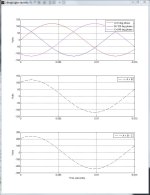Very, very interesting. 6600 Volts on Y ??Are those for different versions of alternators?
Figuring the effects of the phase differences into the diagrams is not something I am capable of. I'm sure Nicola Tesla could look at them and say, "sure, that will work" lol
OK, here's the WHY. I made up a computer 'simulation' of signal generators for 120V, 60 Hz. operation. There are 3 signals: 0 phase lead, 120 degrees of phase lead, and 240 degrees of phase lead. Lead or lag doesn't really matter in the Big picture.
I show on the plot the 3 separate signals (A, B, C) plus combinations of them produced by simply adding or subtracting them. Note that adding 2 together keeps the frequency, produces a single phase and still rolls at 120 Hz.
What is interesting to me is when you add and subtract the 3 signals, it looks like you can still get 60 Hz but can achieve 240v peak to peak. Sure, there's no phantom extra power or current being produced, but you get the picture for the device you are trying to run.

Here's the [MatLab program. You can surely run this concept in Excel, etc.
w=60; % That's w as in omega [ frequency ]
ph=120; % Phase lead increment
t=0:.0005:.015; % generaqte a time base
a=120*sin(2*pi*w*t); % A signal
b=120*sin(2*pi*w*t+1*ph*pi/180); % B signal
c=120*sin(2*pi*w*t+2*ph*pi/180); % C signal
figure('Numbertitle','Off','Menubar','None','Name','3 Phase Signal Additions')
subplot(3,1,1)
plot(t,a,t,b,t,c) % plot all 3 separate signals
ylabel('Volts')
legend('A=0 deg phase','B=120 deg phase','C=240 deg phase')
grid on
subplot(3,1,2)
plot(t,a+b,'k--') % Plot B added to C
ylabel('Volts')
legend('A + B')
grid on
subplot(3,1,3)
plot(t,a+b-c,'k--')
ylabel('Volts')
legend('A + B - C') % Plot A + B - C
grid on
ylabel('Volts')
asp=spline(t,a); % these next computations verify that
[amax,tamax]=fnmax(asp)`% the net frequency is still 60 Hz.
[amin,tamin]=fnmin(asp) % Yes all the frequencies are still 60 Hz.
aHz=1/(2*(tamin-tamax)) % 60 Hz. reported
absp=spline(t,a+b);
[abmax,tabmax]=fnmax(absp)
[abmin,tabmin]=fnmin(absp)
abHz=1/(2*(tabmin-tabmax)) % 60 Hz. reported
abcsp=spline(t,a+b-c);
[abcmax,tabcmax]=fnmax(abcsp)
[abcmin,tabcmin]=fnmin(abcsp)
abcHz=1/(2*(tabcmin-tabcmax)) % 60 Hz. reported
xlabel('Time (seconds)')

